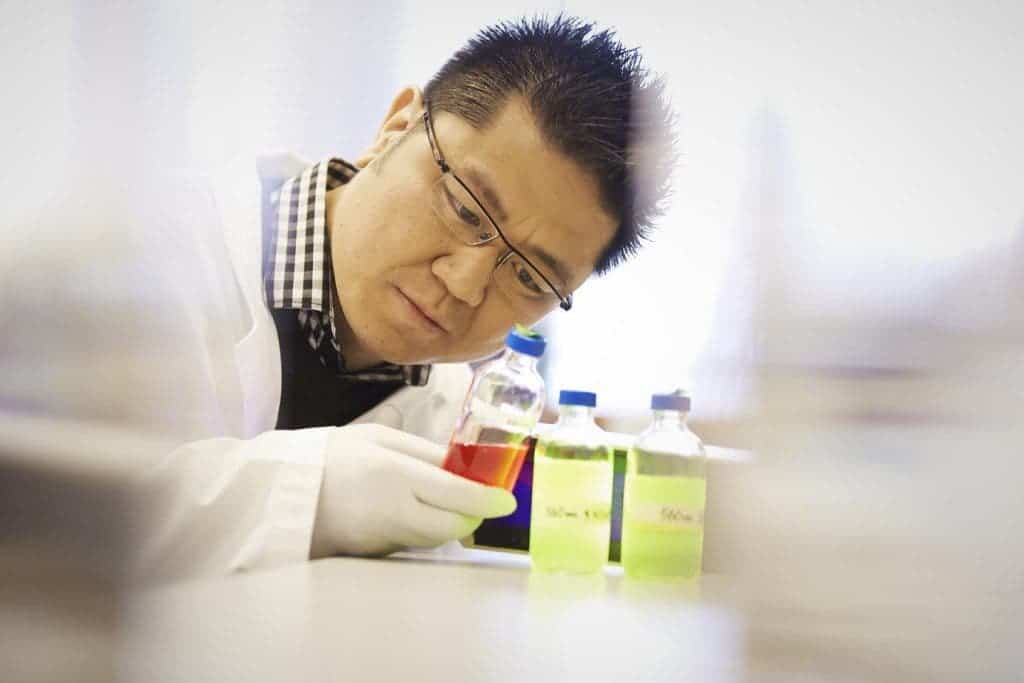University of Toronto researchers have developed a molecular delivery system to administer chemotherapy drugs with as little collateral damage as possible.
Chemotherapy today could be compared to a shotgun — while effective in killing cancerous cells, once in the blood they’re impossible to aim and are just as prone to attacking your own fast-growing cells. This includes hair follicles, skin cells and the ones lining your digestive system, giving chemo patients their distinctive look.
This level of collateral damage — especially in a patient already suffering from a condition as physically and psychically draining as cancer — is unacceptable to Professor Warren Chan. He spent the last ten years working on finding a way to deliver chemotherapy drugs into tumors, and nowhere else.

Image credits NSERC
His work and that of his team has culminated in a set of nanoparticles with strands of DNA attached to them, that can change shape to penetrate into diseased tissue.
“Your body is basically a series of compartments. Think of it as a giant house with rooms inside,” Chan says.
“We’re trying to figure out how to get something that’s outside, into one specific room. One has to develop a map and a system that can move through the house where each path to the final room may have different restrictions such as height and width.”
No two cancerous tumors are identical. Early-stage pancreatic cancer for example responds differently to treatment than prostate cancer, or even pancreatic cancer at a more advanced stage. They not only respond differently, but are different structurally. As such, whether a particle can enter the tumor or not depends on its size, shape or surface chemistry.
Chan and his team have studied the way these factors interact to dictate who gets in and who doesn’t, and have designed the perfect party-crasher molecular delivery system — one that can get in no matter how big the bouncer is. Their system relies on sets of modular nanoparticles that can alter their shape, size and chemical properties when they come in contact with specific DNA sequences.
“We’re making shape-changing nanoparticles,” says Chan.
“They’re a series of building blocks, kind of like a LEGO set.”
These blocks are actually tiny pieces of metal with DNA strands attached. They can be built in a myriad of shapes and have exposed or hidden binding sites. Chan envisions that the nanoparticles will float around harmlessly in the blood until their DNA strand binds to a sequence of marker DNA, known to be indicative of cancer.
As this happens, the particle changes shape and then carries out its function, either attacking the cell with a drug molecule, tagging it with a signal molecule, or whatever else Chan’s team has designed the nanoparticle to do.
“We were inspired by the ability of proteins to alter their conformation — they somehow figure out how to alleviate all these delivery issues inside the body,” says Chan.
“Using this idea, we thought, ‘Can we engineer a nanoparticle to function like a protein, but one that can be programmed outside the body with medical capabilities?'”
Nanotechnology and material sciences are still newcomers in the field of medicine, but Chan thinks there’s promise in their use.
“Here’s how we look at these problems: it’s like you’re going to Vancouver from Toronto, but no one tells you how to get there, no one gives you a map, or a plane ticket, or a car — that’s where we are in this field,” he says.
“The idea of targeting drugs to tumors is like figuring out how to go to Vancouver. It’s a simple concept, but to get there isn’t simple if not enough information is provided.”
The team is now working on a way to deliver enough nanoparticles to tumors to allow for efficient treatment. But Chen is confident their system is sound and that they’ll solve all the teething problems soon.
“We’ve only scratched the surface of how nanotechnology ‘delivery’ works in the body, so now we’re continuing to explore different details of why and how tumors and other organs allow or block certain things from getting in,” Chan concludes.
The full paper, titled “Tailoring nanoparticle designs to target cancer based on tumor pathophysiology” has been published online in the journal Proceedings of the National Academy of Sciences and can be found here.






